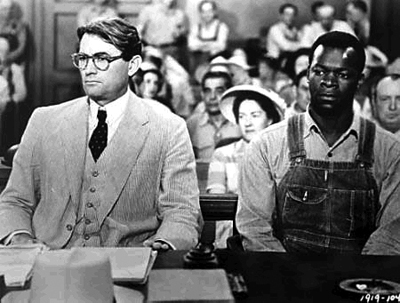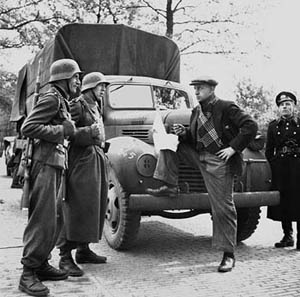During the falling action of a story, the plot winds down, the tension subsides, and the loose ends of the plot resolve. The resolution is where we find out what’s in store for the characters and get a sense of the plot’s closure.

Source: Atticus and Tom Robinson in court, Moni3, Wikimedia
While falling action may contain suspense, its purpose is to move the plot toward a resolution. In an important scene during the falling action of To Kill a Mockingbird, the racial tensions in Maycomb are highlighted and resolved in the story of Tom Robinson. In the excerpt below, Atticus Finch, the white attorney who represents Tom Robinson in a rape trial, is talking with Calpurnia (the family's housekeeper) and Aunt Alexandra about Tom Robinson’s death at the hands of prison guards.
“Cal,” Atticus said, “I want you to go with me out to Helen Robinson’s house—”
“What’s the matter?” Aunt Alexandra asked, alarmed by the look on my father’s face.
“Tom’s dead.”
Aunt Alexandra put her hands to her mouth.
“They shot him,” said Atticus. “He was running. It was during their exercise period. They said he just broke into a blind raving charge at the fence and started climbing over. Right in front of them—”
“Didn’t they try to stop him? Didn’t they give him any warning?” Aunt Alexandra’s voice shook.
“Oh yes, the guards called to him to stop. They fired a few shots in the air, then to kill. They got him just as he went over the fence. They said if he’d had two good arms he’d have made it, he was moving that fast. Seventeen bullet holes in him.
“They didn’t have to shoot him that much. Cal, I want you to come out with me and help me tell Helen.”
“Yes sir,” she murmured, fumbling at her apron. Miss Maudie went to Calpurnia and untied it.
“This is the last straw, Atticus,” Aunt Alexandra said.
“Depends on how you look at it,” he said. “What was one Negro, more or less, among two hundred of ’em? He wasn’t Tom to them, he was an escaping prisoner.”
Atticus leaned against the refrigerator, pushed up his glasses, and rubbed his eyes.
“We had such a good chance,” he said. “I told him what I thought, but I couldn’t in truth say that we had more than a good chance. I guess Tom was tired of white men’s chances and preferred to take his own. Ready, Cal?”
“Yessir, Mr. Finch.”
“Then let’s go.”
The main event of this falling action moves the novel toward its resolution and is a major plot point in the structure of To Kill a Mockingbird. Short stories and novels contain structure, and scenes are the building blocks of structure.
You have probably read books or stories, for example, where smaller stories happen within a larger one. Each smaller story contains its own plot, just like the smaller story in the excerpt above, of Tom Robinson’s last moments. Although the scene that you read serves as falling action in the larger plot of To Kill a Mockingbird, it also has its own plot.
To better understand falling action and resolution and become more familiar with the final parts of a plot, see if you can identify the elements of the excerpt above by answering the questions that follow. Answer each question by clicking on the box next to your choice.

- “I guess Tom was tired of white men’s chances and preferred to take his own.”
Which element of plot does this quotation represent? - “They got him just as he went over the fence.”
Which element of plot does this quotation represent? - “What’s the matter?” Aunt Alexandra asked, alarmed by the look on my father’s face.
Which element of plot does this quotation represent? - Tom Robinson is in prison. Atticus is his defense attorney and a friend of Tom’s loved ones.
These facts represent what plot element within the story of Tom Robinson’s death? - “They said if he’d had two good arms he’d have made it, he was moving that fast. Seventeen bullet holes in him.”
Which element of plot does this quotation represent?
The last excerpt is from The Assault by Harry Mulisch. In this novel about World War II and its aftermath, a young man named Anton trips over clues that help him solve the mystery of his parents’ and brother’s death at the hands of Nazis. This novel has a surprise resolution. In this scene, Anton talks to a woman, a former neighbor. She gives her account of events the night Anton’s family was murdered.

Source: German soldiers guarding a food dump, Alexander M. Stirton, Wikimedia
“And then?” asked Anton.
“After a while the entire army appeared on the quay. I can’t remember how long that took. I was scared to death. Peter kept that thing pointed at our heads, and suddenly there was a lot of noise and shouting outside. I had no idea what he meant to do, and I don’t think he knew himself. He must have realized that he was lost. I’ve often wondered why he didn’t shoot us; by then he had nothing to lose. Perhaps he finally realized that it wasn’t our fault. I mean . . .” she said, looking up at him to see if it was all right to say what she meant.
This scene continues, and the woman adds to Anton’s understanding little by little. Her information is surprising to the reader and to Anton. The unwinding of this plot, like that of “The Interlopers,” shocks and perhaps horrifies the reader. This scene is important to the plot of the story, and, as such, appears at the end to provide the ultimate shock and surprise.
A satisfying resolution to a plot should wrap up all the major plot points. In contemporary fiction, writers sometimes intentionally leave plot elements unresolved, but most fiction you will read follows the model discussed in this lesson.